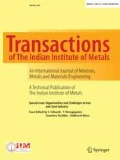Abstract
Product quality depends upon symbiotic inter-dependencies among material, design, tooling and process parameters. Such multifarious relationships make it very difficult to avoid defects in metal casting—still the most economical process to produce large parts with intricate features. To get the quality ‘right first time and every time,’ we need to transform this art into science by leveraging the latest information technologies. Four relevant R&D works carried out by the author and associates over the last three decades are described in this article: (1) user-friendly simulation software to predict casting defects; (2) intelligent design and optimization of methoding and tooling; (3) cloud-based utilities for ubiquitous access; and (4) smart foundry for process data capture and analytics. These are laying the path for new technologies to reduce the difference between designed and manufactured products. Such advanced and inter-disciplinary projects are also changing the mind-set about metal casting and attracting the next generation of researchers.













Similar content being viewed by others
References
Ravi B, Metal Casting: Computer-Aided Design and Analysis, PHI India, New Delhi (2005).
Campbell J, Castings, Butterworth-Heinemann, USA (2003).
Ravi B, and Joshi D, Indian Found J 56 (2010) 23.
Ravi B, in Proceedings of the 48th Indian Foundry Congress, Institute of Indian Foundrymen, Coimbatore (2000).
Ravi B, and Srinivasan MN, Trans Am Found Soc 98 (1990) 353.
Sutaria M, Joshi D, Jagdishwar M, and Ravi B, Trans Am Found Soc 119 (2011).
Ravi B, Trans Indian Inst Met 65 (2012) 521.
Sutaria M, and Ravi B, Int J Adv Manuf Technol 75 (2014) 209.
Roschen S, Jacob E, Savithri S, Kumar M, and Ravi M, Met Mater Process 13 (2001) 361.
Savithri S, Roschen S, Jacob E, Chourasia V, Sivakumar YVM, and Lanka B, Indian Found J 60 (2014) 21.
Ravi B, Savithri S, Roschen S, Marwah AM, Trans Indian Inst Met 68 (2015) 1227.
Shinde V, Joshi D, Ravi B, and Narasimhan K, J Mater Eng Perform 22 (2013) 1558.
Renukananda K H, and Ravi B, J Mater Manuf Process 31 (2016), 1091.
Chougule R G, Jalan M K, and Ravi B, Trans Am Found Soc 112 (2004) 105.
Ravi B, Mater Sci Technol 13 (1997) 785.
Ravi B, Creese R C, and Ramesh D, Trans Am Found Soc 107 (1999).
Ravi B, and Srinivasan M N, Comput Aided Des 22 (1990) 11.
Ravi B, and Srinivasan M N, in Proceedings of the Int. Conf. on Design Automation, Coimbatore, India (1991).
Ravi B, and Srinivasan M N, Int J Prod Res 33 (1995) 3367.
Subburaj K, Patil S, and Ravi B, Int J CAD/CAM 6 (2006) 101.
Joshi D, and Ravi B, Trans Am Found Soc 117 (2009) 7.
Nagahanumaiah, Ravi B, and Mukherjee N P, Int J Adv Manuf Technol 26 (2005), 1138.
Chougule R G, and Ravi B, Int J Comput Integr Manuf 19 (2006) 676.
Ravi B, in Proceedings of the 60th Indian Foundry Congress, Institute of Indian Foundrymen, Bangalore (2012).
Ravi B, in Proceedings of the 71st World Foundry Congress, Bilbao, Spain (2014).
Allen D, Met Cast Technol 66 (2020) 16.
Ravi B, IEEE Potentials 35 (2016) 29.
Akarte M M, and Ravi B, Int J Prod Res 45 (2007) 4917.
Khandelwal H, Gunjal S, and Ravi B, Indian Found J 62 (2016) 47.
Sata A, and Ravi B, Int J Adv Manuf Technol 90 (2017) 3301.
Acknowledgements
The research work described in this paper spanned three decades and involved more than one hundred researchers, engineers and industry experts from multiple disciplines and organizations. Those who led the projects or made significant contributions deserve special mention. It includes Ramesh Dommeti, who developed the first version of AutoCAST, and Kaustubh Moharir, who developed AutoCAST-X. The tooling design module was created by 3D Foundry Tech team led by BabaPrasad Lanka. The FLOW+ software was developed by Dr. Roschen Sasikumar, Dr. Savithri Sivaraman and Dr. Elizabeth Jacob at CSIR-NIIST, Thiruvananthapuram. Relevant experimental studies were carried out by Dr. MM Akarte, Dr. RG Chougule, Dr. Dinesh Pal, Dr. K. Subburaj, Dr. KH Renukananda and Dr. Himanshu Khandelwal. The E-Foundry project involved Dr. Durgesh Joshi from Indore (who sadly passed away in a road accident), Dr. Mayur Sutaria from Changa, Dr. Amit Sata from Rajkot, and Dr. Vasudev Shinde from Icchalkaranji. The SMART Foundry project brought in additional researchers including Prof. A.M. Kuthe from Nagpur, Prof. Goutam Sutradhar from Kolkata (later Manipur), Dr. Nagahanumaiah from Durgapur (later Bangalore) and Dr. Arati Mulay from Pune. The support of government agencies—National Knowledge Network for E-Foundry project, Department of Science and Technology for the SMART Foundry project, and industry (mainly 3D Foundry Tech) for software development is gratefully acknowledged. The technologies were refined with valuable inputs from many casting experts. The implicit support of the parent institutions of the researchers in sustaining the above projects over many years helped in crossing the ‘valleys of death’ from scientific concepts to practical applications.
Author information
Authors and Affiliations
Corresponding author
Additional information
Publisher's Note
Springer Nature remains neutral with regard to jurisdictional claims in published maps and institutional affiliations.
Rights and permissions
About this article
Cite this article
Ravi, B. Metal Casting 4.0: Closing the Loop Between Design and Manufacturing. Trans Indian Inst Met 74, 1017–1028 (2021). https://doi.org/10.1007/s12666-020-02152-y
Received:
Accepted:
Published:
Issue Date:
DOI: https://doi.org/10.1007/s12666-020-02152-y




